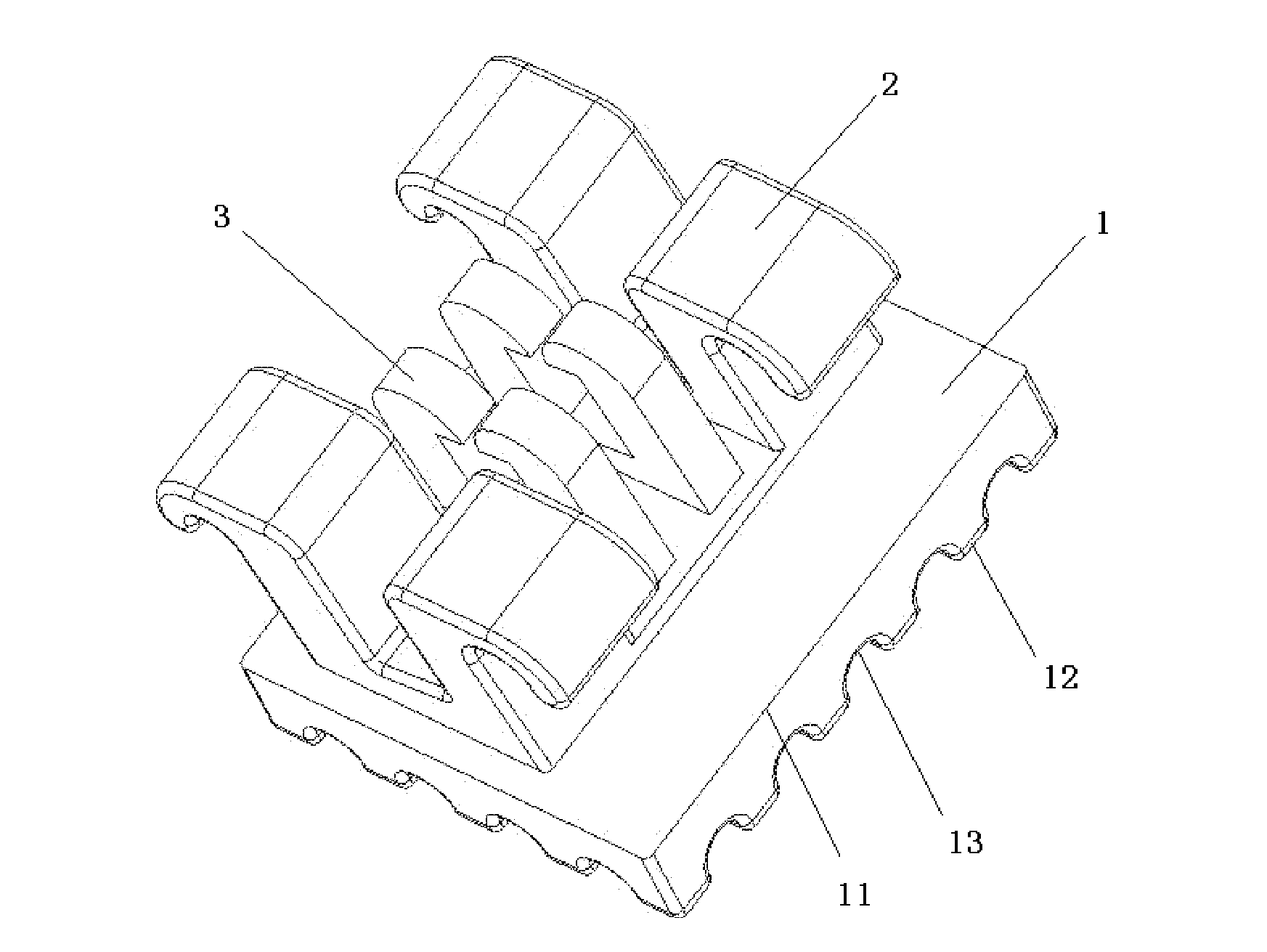Monolithic metallic self-ligating bracket with locking catch devices
- Summary
- Abstract
- Description
- Claims
- Application Information
AI Technical Summary
Benefits of technology
Problems solved by technology
Method used
Image
Examples
embodiment 1
[0037]As shown in FIG. 1 and FIG. 2, the self-ligating bracket of present embodiment including base 1, two tie wings 2, 2N locking catch devices 3 (N is natural number), wherein tie wing 2 and locking catch devices 3 and base 1 are processed by integral shaping method such as metal casting, metal powder injection molding (MIM), linear cutting and so on. The self-ligating bracket is made of metallic material in its entirety, such as Nickel-Titanium alloy, Nickel-Titanium based alloys, Titanium based alloys, Co—Cr alloys or Stainless Steel. Base 1 is a board with generally cuboid shape, whose front side is surface 11, back side is the bonding surface 12, wherein surface 11 is a smooth plane, the bonding surface 12 is with a ravine like grooves 13 in favor for binder's inflow to enhance the retention force of the bracket. Two tie wings 2 are placed in a mesial and distal direction of the surface 11 respectively, wherein tie wing 2 includes a support 21 that connected with surface 11, a...
embodiment 2
[0040]As showed in FIG. 4, on the basis of embodiment 1, the self-ligating bracket of the present embodiment is without the locking catch devices 3 that placed in the space between two tie wings 2, and there is a group of locking catch devices 3 placed on each external side of the two tie wings on the surface 11 along the slot 22 axis. The locking catch devices 3 of each group are symmetrically placed on the two sides of the axis of slot 22 and the two locking catch devices 3 of one group join up at the base of the trailing arm 31, the shape of the cavity between the two locking catch devices 3 is a roughly upturned “C” type with its mouth upward. The shape of the cavity between the two locking catch devices 3 is in conformity with the inner contour of the slot 22, the cavity and slot 22 form the archwire concave 4 together, which enhances the control and enclasping ability on an arch wire, and keeps the arch wire fixed without bounce off from the archwire concave 4 within certain l...
embodiment 3
[0041]As showed in FIG. 5, on the basis of embodiment 1, the self-ligating bracket of the present embodiment is with a group of locking catch devices 3 placed on each external side of the two tie wings 2 on the surface 11 along the axis of slot 22. The two locking catch devices 3 of each group are symmetrically placed on the two sides of the axis of slot 22 and the two locking catch devices 3 of one group join up at the base of the trailing arm 31. The shape of the cavity between the two locking catch devices 3 is a roughly upturned “C” type with its mouth upward. The shape of the cavity between the two locking catch devices 3 is in conformity with the inner contour of the slot 22, the cavity and slot 22 form the archwire concave 4 together, which enhances the control and enclasping ability on a arch wire, and keeps the arch wire fixed without bounce off from the archwire concave 4 within certain limits.
PUM
 Login to View More
Login to View More Abstract
Description
Claims
Application Information
 Login to View More
Login to View More - R&D
- Intellectual Property
- Life Sciences
- Materials
- Tech Scout
- Unparalleled Data Quality
- Higher Quality Content
- 60% Fewer Hallucinations
Browse by: Latest US Patents, China's latest patents, Technical Efficacy Thesaurus, Application Domain, Technology Topic, Popular Technical Reports.
© 2025 PatSnap. All rights reserved.Legal|Privacy policy|Modern Slavery Act Transparency Statement|Sitemap|About US| Contact US: help@patsnap.com



